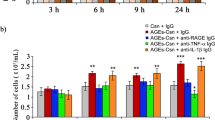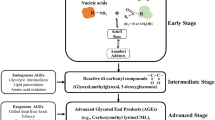Abstract
Background
Advanced glycation end products (AGE) and the receptor for advanced glycation end products (RAGE) are closely associated with colorectal cancer progression. The association between RAGE and AGE in colon carcinogenesis needs to be clarified.
Methods
Levels of RAGE and AGE were examined in azoxymethane (AOM)-injected Fischer 344 rats fed a control diet (Group C), a 15 % linoleic acid (LA) diet (Group L), a control diet with 10 % glucose drink (Group G), and a 15 % LA diet with 10 % glucose drink (Group L + G). Group L + G showed the most pronounced increase of body weight, blood sugar, and serum insulin.
Results
The rats in Group L + G showed the most pronounced multiplicity of aberrant crypt foci (ACF) and carcinomas with increased mucosal RAGE and AGE. IEC6 rat intestinal epithelial cells treated with AGE showed increased RAGE expression, which was inhibited by treatment with metformin or losartan. In the AOM-injected rat colon cancer model, the levels of RAGE and AGE, and the multiplicity of ACF and carcinomas, in Group L + G rats were suppressed by treatment with metformin or losartan.
Conclusions
These results suggest that AGE–RAGE induced by high-LA and high-glucose diets substantially enhances colon cancer development; thus, suppression of AGE–RAGE could be a potential target for colon cancer chemoprevention.







Similar content being viewed by others
Abbreviations
- AGE:
-
Advanced glycation end products
- RAGE:
-
Receptor for advanced glycation end products
- CRC:
-
Colorectal cancer
- LA:
-
Linoleic acid
- AOM:
-
Azoxymethane
- ROS:
-
Reactive oxygen species
- PUFA:
-
Polyunsaturated fatty acid
- BSA:
-
Bovine serum albumin
- MMP:
-
Matrix metalloproteinase
- VEGF:
-
Vascular endothelial growth factor
- iNOS:
-
Inducible nitric oxide synthase
- ACF:
-
Aberrant crypt foci
- HMGB:
-
High mobility group box
- NF:
-
Nuclear factor
- ERK:
-
Extracellular signal-regulated kinase
- JNK:
-
c-Jun N-terminal kinase
References
Lalla E, Lamster IB, Schmidt AM. Enhanced interaction of advanced glycation end products with their cellular receptor RAGE: implications for the pathogenesis of accelerated periodontal disease in diabetes. Ann Periodontol. 1998;3:13–9.
Hori O, Yan SD, Ogawa S, Kuwabara K, Matsumoto M, Stern D, et al. The receptor for advanced glycation end-products has a central role in mediating the effects of advanced glycation end-products on the development of vascular disease in diabetes mellitus. Nephrol Dial Transplant. 1996;11:13–6.
Schmidt AM, Hofmann M, Taguchi A, Yan SD, Stern DM. RAGE: a multiligand receptor contributing to the cellular response in diabetic vasculopathy and inflammation. Semin Thromb Hemost. 2000;26:485–93.
Yamagishi S, Takeuchi M, Inagaki Y, Nakamura K, Imaizumi T. Role of advanced glycation end products (AGEs) and their receptor (RAGE) in the pathogenesis of diabetic microangiopathy. Int J Clin Pharmacol Res. 2003;23:129–34.
Yamamoto Y, Yamagishi S, Yonekura H, Doi T, Tsuji H, Kato I, et al. Roles of the AGE–RAGE system in vascular injury in diabetes. Ann N Y Acad Sci. 2000;902:163–70.
Abe R, Yamagishi S. AGE–RAGE system and carcinogenesis. Curr Pharm Des. 2008;14:940–5.
Schmidt AM, Yan SD, Wautier JL, Stern D. Activation of receptor for advanced glycation end products: a mechanism for chronic vascular dysfunction in diabetic vasculopathy and atherosclerosis. Circ Res. 1999;84:489–97.
Huttunen HJ, Fages C, Rauvala H. Receptor for advanced glycation end products (RAGE)-mediated neurite outgrowth and activation of NF-κB require the cytoplasmic domain of the receptor but different downstream signaling pathways. J Biol Chem. 1999;274:19919–24.
Huttunen HJ, Fages C, Kuja-Panula J, Ridley AJ, Rauvala H. Receptor for advanced glycation end products-binding COOH-terminal motif of amphoterin inhibits invasive migration and metastasis. Cancer Res. 2002;62:4805–11.
Taguchi A, Blood DC, del Toro G, Canet A, Lee DC, Qu W, et al. Blockade of RAGE–amphoterin signalling suppresses tumour growth and metastases. Nature. 2000;405:354–60.
Kuniyasu H, Oue N, Wakikawa A, Shigeishi H, Matsutani N, Kuraoka K, et al. Expression of receptors for advanced glycation end-products (RAGE) is closely associated with the invasive and metastatic activity of gastric cancer. J Pathol. 2002;196:163–70.
Kuniyasu H, Chihara Y, Takahashi T. Co-expression of receptor for advanced glycation end products and the ligand amphoterin associates closely with metastasis of colorectal cancer. Oncol Rep. 2003;10:445–8.
Kuniyasu H, Chihara Y, Kondo H, Ohmori H, Ukai R. Amphoterin induction in prostatic stromal cells by androgen deprivation is associated with metastatic prostate cancer. Oncol Rep. 2003;10:1863–8.
Bhawal UK, Ozaki Y, Nishimura M, Sugiyama M, Sasahira T, Nomura Y, et al. Association of expression of receptor for advanced glycation end products and invasive activity of oral squamous cell carcinoma. Oncology. 2005;69:246–55.
Huttunen HJ, Kuja-Panula J, Sorci G, Agneletti AL, Donato R, Rauvala H. Coregulation of neurite outgrowth and cell survival by amphoterin and S100 proteins through receptor for advanced glycation end products (RAGE) activation. J Biol Chem. 2000;275:40096–105.
Kuniyasu H, Chihara Y, Kondo H. Differential effects between amphoterin and advanced glycation end products on colon cancer cells. Int J Cancer. 2003;104:722–7.
Sasahira T, Kirita T, Bhawal UK, Ikeda M, Nagasawa A, Yamamoto K, et al. The expression of receptor for advanced glycation end products is associated with angiogenesis in human oral squamous cell carcinoma. Virchows Arch. 2007;450:287–95.
Sasahira T, Akama Y, Fujii K, Kuniyasu H. Expression of receptor for advanced glycation end products and HMGB1/amphoterin in colorectal adenomas. Virchows Arch. 2005;446:411–5.
Inoue M, Iwasaki M, Otani T, Sasazuki S, Tsugane S. Public awareness of risk factors for cancer among the Japanese general population: a population-based survey. BMC Public Health. 2006;6:2.
Sato T, Iwaki M, Shimogaito N, Wu X, Yamagishi S, Takeuchi M. TAGE (toxic AGEs) theory in diabetic complications. Curr Mol Med. 2006;6:351–8.
Yao D, Brownlee M. Hyperglycemia-induced reactive oxygen species increase expression of the receptor for advanced glycation end products (RAGE) and RAGE ligands. Diabetes. 2010;59:249–55.
Nishikawa T, Edelstein D, Du XL, Yamagishi S, Matsumura T, Kaneda Y, et al. Normalizing mitochondrial superoxide production blocks three pathways of hyperglycaemic damage. Nature. 2000;404:787–90.
Schurman L, McCarthy AD, Sedlinsky C, Gangoiti MV, Arnol V, Bruzzone L, et al. Metformin reverts deleterious effects of advanced glycation end-products (AGEs) on osteoblastic cells. Exp Clin Endocrinol Diabetes. 2008;116:333–40.
Bellin C, de Wiza DH, Wiernsperger NF, Rosen P. Generation of reactive oxygen species by endothelial and smooth muscle cells: influence of hyperglycemia and metformin. Horm Metab Res. 2006;38:732–9.
Sebekova K, Schinzel R, Munch G, Krivosikova Z, Dzurik R, Heidland A. Advanced glycation end-product levels in subtotally nephrectomized rats: beneficial effects of angiotensin II receptor 1 antagonist losartan. Miner Electrolyte Metab. 1999;25:380–3.
Singh J, Hamid R, Reddy BS. Dietary fish oil inhibits the expression of farnesyl protein transferase and colon tumor development in rodents. Carcinogenesis. 1998;19:985–9.
Rao CV, Simi B, Wynn TT, Garr K, Reddy BS. Modulating effect of amount and types of dietary fat on colonic mucosal phospholipase A2, phosphatidylinositol-specific phospholipase C activities, and cyclooxygenase metabolite formation during different stages of colon tumor promotion in male F344 rats. Cancer Res. 1996;56:532–7.
Zhou S, Wang G, Chen B, Wang P. Effect of dietary fatty acids on tumorigenesis of colon cancer induced by methyl nitrosourea in rats. J Environ Pathol Toxicol Oncol. 2000;19:81–6.
Simopoulos AP. Evolutionary aspects of diet, the omega-6/omega-3 ratio and genetic variation: nutritional implications for chronic diseases. Biomed Pharmacother. 2006;60:502–7.
Simopoulos AP. Essential fatty acids in health and chronic disease. Am J Clin Nutr. 1999;70:560S–9S.
McLellan EA, Medline A, Bird RP. Sequential analyses of the growth and morphological characteristics of aberrant crypt foci: putative preneoplastic lesions. Cancer Res. 1991;51:5270–4.
Pugliese G, Pricci F, Leto G, Amadio L, Iacobini C, Romeo G, et al. The diabetic milieu modulates the advanced glycation end product-receptor complex in the mesangium by inducing or upregulating galectin-3 expression. Diabetes. 2000;49:1249–57.
Shimoda H, Nakamura S, Morioka M, Tanaka J, Matsuda H, Yoshikawa M. Effect of cinnamoyl and flavonol glucosides derived from cherry blossom flowers on the production of advanced glycation end products (AGEs) and AGE-induced fibroblast apoptosis. Phytother Res. 2011.
De Bellis D, Horowitz MI. In vitro studies of histone glycation. Biochim Biophys Acta. 1987;926:365–8.
Bull NL. Dietary habits, food consumption, and nutrient intake during adolescence. J Adolesc Health. 1992;13:384–8.
Campos FG, Logullo Waitzberg AG, Kiss DR, Waitzberg DL, Habr-Gama A, Gama-Rodrigues J. Diet and colorectal cancer: current evidence for etiology and prevention. Nutr Hosp. 2005;20:18–25.
Stern DM, Yan SD, Yan SF, Schmidt AM. Receptor for advanced glycation endproducts (RAGE) and the complications of diabetes. Ageing Res Rev. 2002;1:1–15.
Li J, Schmidt AM. Characterization and functional analysis of the promoter of RAGE, the receptor for advanced glycation end products. J Biol Chem. 1997;272:16498–506.
Li J, Qu X, Schmidt AM. Sp1-binding elements in the promoter of RAGE are essential for amphoterin-mediated gene expression in cultured neuroblastoma cells. J Biol Chem. 1998;273:30870–8.
Huttunen HJ, Rauvala H. Amphoterin as an extracellular regulator of cell motility: from discovery to disease. J Intern Med. 2004;255:351–66.
Yan SD, Chen X, Fu J, Chen M, Zhu H, Roher A, et al. RAGE and amyloid-beta peptide neurotoxicity in Alzheimer’s disease. Nature. 1996;382:685–91.
Ohmori H, Luo Y, Fujii K, Sasahira T, Shimomoto T, Denda A, et al. Dietary linoleic acid and glucose enhances azoxymethane-induced colon cancer and the metastasis through the expression of high mobility group box 1. Pathobiology. 2010;77:210–7.
Lee CI, Guh JY, Chen HC, Hung WC, Yang YL, Chuang LY. Advanced glycation end-product-induced mitogenesis and collagen production are dependent on angiotensin II and connective tissue growth factor in NRK-49F cells. J Cell Biochem. 2005;95:281–92.
Leiter LA, Lewanczuk RZ. Of the renin-angiotensin system and reactive oxygen species type 2 diabetes and angiotensin II inhibition. Am J Hypertens. 2005;18:121–8.
Yamamoto K, Kitayama W, Denda A, Morisaki A, Kuniyasu H, Kirita T. Inhibitory effects of selective cyclooxygenase-2 inhibitors, nimesulide and etodolac, on the development of squamous cell dysplasias and carcinomas of the tongue in rats initiated with 4-nitroquinoline 1-oxide. Cancer Lett. 2003;199:121–9.
Ge QM, Dong Y, Su Q. Effects of glucose and advanced glycation end products on oxidative stress in MIN6 cells. Cell Mol Biol (Noisy-le-grand). 2010;56 Suppl:OL1231–8.
Reddy VP, Beyaz A. Inhibitors of the Maillard reaction and AGE breakers as therapeutics for multiple diseases. Drug Discov Today. 2006;11:646–54.
Rahbar S. Novel inhibitors of glycation and AGE formation. Cell Biochem Biophys. 2007;48:147–57.
Conflict of interest
We declare that there is no financial support and no relationships which may pose a conflict of interest in the contents of the submitted manuscript. All authors have approved the comments.
Author information
Authors and Affiliations
Corresponding author
Rights and permissions
About this article
Cite this article
Shimomoto, T., Luo, Y., Ohmori, H. et al. Advanced glycation end products (AGE) induce the receptor for AGE in the colonic mucosa of azoxymethane-injected Fischer 344 rats fed with a high-linoleic acid and high-glucose diet. J Gastroenterol 47, 1073–1083 (2012). https://doi.org/10.1007/s00535-012-0572-5
Received:
Accepted:
Published:
Issue Date:
DOI: https://doi.org/10.1007/s00535-012-0572-5




